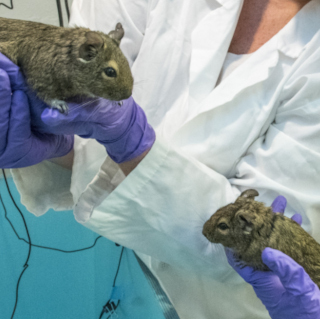Ulcerative Dermatitis
Objective Measurement Within the LAR Vivarium
Last Review Date: September 24, 2020
I. Purpose/Scope
The purpose of this Standard Operating Procedure (SOP) is to outline the procedure for LAR staff members to objectively score ulcerative dermatitis (UD) within the LAR vivariums. This scoring system will enable LAR staff to make objective decisions regarding the euthanasia of animals severely affected by UD.
II. Policy
It is LAR policy to meet or exceed all federal, state and local regulations and guidelines and to comply with all institutional policies and procedures as they apply to the use of animals in research. Personnel must attend any applicable training in animal care and use, occupational health and safety, equipment operation, and SOP’s prior to performing activities outlined in this SOP or work under the direct supervision of trained LAR personnel.
III. UD Scoring System
The UD scoring system provides an objective measure with which to determine if a mouse is unresponsive to therapeutic treatments and may be reaching a point in the disease process that affects their quality of life. This scoring system is easy to perform and interpret and provides an objective measure with which to make decisions regarding euthanasia for mice affected by UD.
The UD scoring system is based on a 0 to 100 scale, with 100 being the most severe score. A threshold score of 75 should initiate contact between the LAR staff member and the Attending Veterinarian, Principal Investigator (PI), or colony manager to recommend euthanasia for the affected mouse.
This scoring system has four parameters that are assessed and recorded in the animal health record.
A. Scratching Number
The affected mouse is observed for 2 minutes. Each time a fore or rear paw is raised to
scratch, it is counted.
B. Characterization of the Lesion (COL)
Lesions are assigned a score based on the severity of the lesion(s) described in the chart
below.
C. Length of Lesion (LOL)
The length of the longest diameter of the most extensive lesion is measured. This
measurement should not cross over clinically normal skin.
D. Region Affected (RA)
A score is determined by the region on the body affected and the number of affected
areas (see Figure 1).
UD Severity Score Chart
| Scratching Number | Score |
| None | 0 |
| <5 | 1 |
| 5-10 | 2 |
| >10 | 3 |
| Characterization of the Lesion | Score |
| No lesions present | 0 |
| Excoriations or one small (<2mm) punctate crust | 1 |
| Multiple, small punctate crusts or coalescing crusts >2 mm | 2 |
| Erosions or ulcerations present | 3 |
| Length of Lesion | Score |
| 0 cm | 0 |
| <1 cm | 1 |
| 1-2 cm | 2 |
| >2 cm | 3 |
| Region Affected | Score |
| None | 0 |
| Regions 2 or 3 | 1 |
| Regions 2 and 3 | 2 |
| Region 1 +/- other affected regions | 3 |
| TOTAL UD SCORE |
Once all of the above values are scored, the formula to calculate the Severity Score
Formula is as follows: (A + B + C + D)/ 12] x 100
Figure 1. Regions Affected on the Mouse

Region 1: The head cranial to the point of ear attachments and/or lesions affecting the
mandible: ventrally from the mandible to the thoracic inlet.
Region 2: Inner and outer ear, dorsal cervical region c
attachments, dorsal and ventral thorax, as well as thoracic limbs.
Region 3: Any region caudal to the ribcage.
IV. Severity Score Assigned to the Affected Animal
Once a Severity Score is calculated for the affected animal, the score is recorded in the Animal Health Records. Once the Severity Score reaches the threshold score of 75, the AV, PI, and colony manager should be alerted and a recommendation to euthanize the affected animal made.
V. Reference
Hampton AL, Hish GA, Aslam MN, Rothman ED, Gergin, IL, Patterson, KA, Naik M, Paruchuri T, Varani J, Rush HG. 2012. Progression of Ulcerative Dermatitis Lesions in C57BL/6Crl Mice and the Development of a Scoring System for Dermatitis Lesions. Journal of American Association of Laboratory Animal Science 51(5); 586-593.
